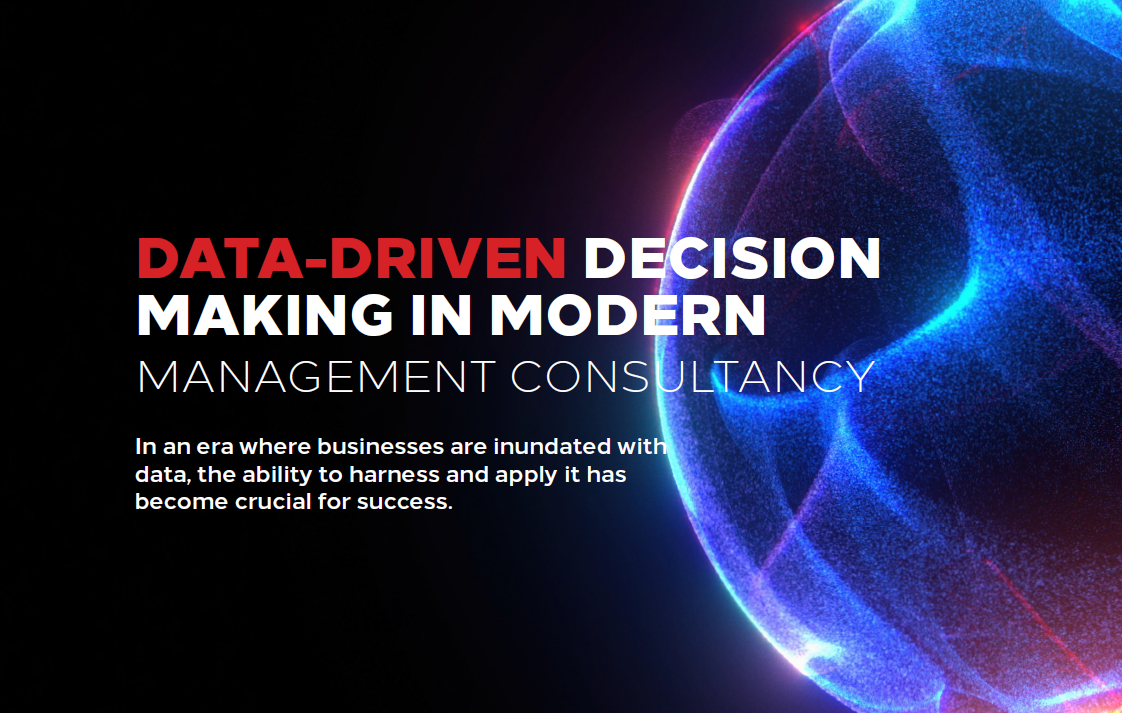Data-Driven Decision Making in Modern Management Consultancy
DATA-DRIVEN DECISION MAKING IN MODERN MANAGEMENT CONSULTANCY In an era where businesses are inundated with data, the ability to harness and apply it has become crucial for success. In an era where businesses are inundated with data, the ability to harness and apply it has become crucial for success. Data-driven decision-making (DDDM) is an approach where decisions are guided by data analysis and interpretation, rather than intuition alone. For management consultants, this practice has not only become a tool but a differentiator, offering clients insights rooted in evidence rather than assumptions. In this article, we will explore the role of data-driven decision-making in modern management consultancy, the benefits it brings to clients, and the strategies consultants use to maximize the impact of DDDM. THEIMPORTANCEOF DATA INMANAGEMENTCONSULTANCY → Traditionally, management consultants relied on market research, case studies, and expert opinion to guide their recommendations. While these methods remain important, they often lack the immediacy and specificity that data-driven insights provide. Today’s business environment demands rapid, responsive decision-making to keep up with changing markets and customer expectations. Data-driven decision-making equips consultants with the means to deliver solutions that are both timely and targeted.In management consultancy, data-driven insights allow consultants to pinpoint specific issues within a business, test hypotheses in real time, and forecast potential outcomes with greater accuracy. Whether optimizing a supply chain, identifying consumer trends, or enhancing employee performance, the application of data analytics ensures that recommendations are grounded in factual evidence, increasing the likelihood of successful outcomes. BENEFITS OFDATA-DRIVEN DECISIONMAKING INCONSULTANCY The benefits of DDDM in consultancy are manifold, offering clients enhanced accuracy, agility, and competitiveness. Let’s examine the primary advantages: INCREASEDAGILITY Data allows consultants to respond quickly to changes in the business environment. In times of economic uncertainty or market shifts, consultants can continuously monitor data and adjust strategies accordingly, ensuring their clients remain resilient. By using real-time data, management consultants can help clients make informed decisions with agility, enabling them to pivot as needed without the delays of lengthy data gathering processes. ENHANCEDACCURACY DDDM reduces the risk of errors and misjudgments that can stem from relying solely on intuition or historical precedent. Consultants can analyze past performance, track industry trends, and even consider external factors to make more accurate recommendations. For example, predictive analytics can allow consultants to anticipate customer behavior or supply chain bottlenecks, enabling businesses to proactively address potential issues. GREATERCOMPETITIVENESS In competitive industries, where margins and market share are tight, data-driven decision-making offers a significant edge. By leveraging data to inform strategic initiatives, consultants enable their clients to not only meet market demands but anticipate them. Whether it’s adapting to consumer demands, fine-tuning operational processes, or exploring new markets, DDDM can position clients ahead of their competitors. DESCRIPTIVEANALYTICS THE ROLE OF DATA ANALYSIS TECHNIQUES IN DDDM Management consultants use a variety of data analysis techniques to uncover insights. Key methods include: SENTIMENTANALYSIS PRESCRIPTIVEANALYTICS PREDICTIVEANALYTICS IMPLEMENTING DATA-DRIVEN DECISION MAKING IN CONSULTANCY PROJECTS For data-driven decision-making to be effective, it needs to be implemented with a clear strategy. This involves several key steps: Define Clear Objectives: Consultants must understand the client’s goals and challenges to identify the right data and analytics approach. Whether the aim is to boost customer satisfaction or reduce operational costs, defining objectives is crucial. Data Collection and Cleaning: The quality of the data directly impacts the quality of insights derived. Consultants must ensure that data collected from various sources is accurate, complete, and relevant. Data cleaning is an essential step, as erroneous data can lead to misleading conclusions. Data Integration and Analysis: By integratingdata from different sources—such as CRMsystems, market research reports, and operationaldata—consultants can gain a comprehensive view.Advanced analytics tools and techniques, such as artificial intelligence and machine learning, allow consultants to extract deep insights from the data. Presenting Actionable Insights: Findings should be presented in a manner that is easily understood and actionable for the client. Data visualizations, dashboards, and interactive reports can make complex data more accessible, helping clients see the value of the data and make informed decisions. CHALLENGES INDATA-DRIVENDECISION MAKING Despite its advantages, implementing DDDM is not without challenges. Data privacy and security concerns are paramount, as clients must protect sensitive information from potential breaches. Additionally, there’s the challenge of data overload; without proper filtering, the vast amounts of data available today can be overwhelming. Consultants must ensure that the data used is relevant, actionable, and aligned with the client’s objectives. Moreover, a lack of data literacy within client organizations can limit the effectiveness of data-driven recommendations. It is often necessary for consultants to provide training or guidance to ensure that clients understand how to interpret and apply the data insights they receive. CONCLUSION Data-driven decision-making has revolutionized modern management consultancy, providing a powerful tool for consultants to deliver value to their clients in a fast-paced, complex business environment. By integrating descriptive, predictive, and prescriptive analytics into their processes, consultants can offer solutions that are not only well-informed but also agile and competitive. While challenges such as data privacy and overload persist, the benefits of DDDM in improving accuracy, agility, and competitiveness far outweigh these issues. As businesses continue to recognize the value of data-driven insights, the role of DDDM in consultancy will only grow, setting a new standard for informed, strategic decision-making in the industry.



